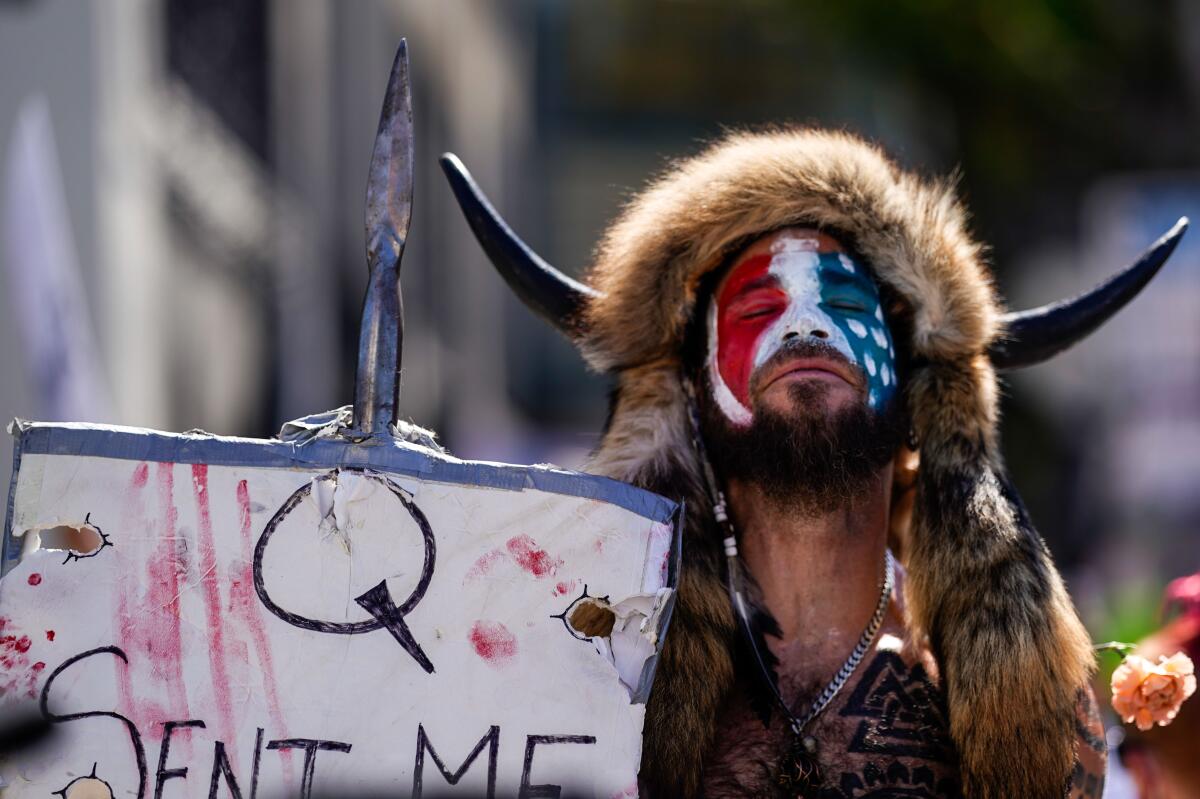What I learned about Islamic State applies to QAnon too

- Share via
For much of the public, the face of the Jan. 6 insurrection was an animal pelt-wearing man with face paint and horns, performing like a pagan god-king. Jacob Chansley’s self-styled nickname, the “QAnon shaman,” brought the country’s most potent conspiracy theory — one alleging that liberal elites are Satanic child-sex-trafficking cannibals — right into our news streams.
With a brand ambassador like Chansley, it’s easy, and probably satisfying, to dismiss QAnon followers as deranged, troubled and separate from the rest of us. But that is not the case. Most QAnon followers lead largely mainstream lives. Drawing a stark line between them and everyone else will only impair our understanding of this phenomenon and undercut effective ways to curb it.
For five years at the Central Intelligence Agency, I researched the psychology of Islamic State foreign fighters who left the West to join the terrorist group in Iraq and Syria. While Islamic State ideology is not widely considered a conspiracy theory, the group’s main objective — to militarily destroy the West — is as unlikely to come to pass as Hillary Clinton secretly eating children.
My counterterrorism research taught me that beliefs are squishy things. They are often far less tethered to truth than people will admit. And most people who fall into conspiracy theories have otherwise normal personality traits that, under certain circumstances, make them vulnerable to extreme views or behavior. Those circumstances played out violently with encouragement from President Trump, who created and fed the big lie that the election was stolen.
As we learn more about the alleged Capitol rioters — the real estate agent from Texas, the lawyer from Georgia, the pool-service owner from San Diego — they seem to display core characteristics long associated with conspiracy theory vulnerability: an identity-related grievance, a penchant for anger and metaphysical belief.
This openness to metaphysical forces — the view the world hosts a struggle between good and evil and a belief in a higher power with a plan — appears to make some religious individuals more susceptible. A recent survey by the American Enterprise Institute found that 27% of white evangelicals nationwide believe in QAnon. Flags seen at the Jan. 6 insurrection read, “Jesus is my savior, Trump is my president.” The QAnon shaman, photographed in the Senate chamber, was heard leading a group in prayer.
Making the jump from religious devotion to conspiracy theories requires an animating emotion, namely anger. Those who respond to troubling events with anger rather than fear tend to feel a surge of power and control. Perhaps most importantly, conspiracy theorists are almost always lured by gaining psychological benefits from their beliefs.
While many of those arrested in the Capitol assault were in financial trouble, according to the Washington Post, destitution was not their problem. Abject poverty alone is rarely a driver toward extreme ideology. Terrorist groups and conspiracy cults nearly always have educated professionals. This suggests that extreme belief is less animated by severe want and more by unattained expectations and grievances.
At the CIA, most of the Islamic State recruits I studied were Muslim men in their early 20s. Their parents had immigrated to Europe and significantly upgraded their family’s prospects, a truly remarkable feat. Their young sons attained degrees in technology, but often struggled to find work, good friends or a path to a respectable adulthood. Unattained expectations and often long nights on the internet made them highly vulnerable to Islamic State propaganda.
Most foreign fighters in Islamic State found the group through friends who were already radicalized, through recruiters in Syria reaching out over the internet, or through online videos. These videos — often produced by Islamic State — emphasized exclusion grievances, cultural threats toward Muslims and a military movement offering the prospect of glory. Recruits then found online discussion groups where they would connect with recruiters in Syria who sent instructions on how to travel to Islamic State.
With Americans in QAnon, the demographics are different. Most supporters are middle-aged whites, many with stable jobs and businesses. As with Islamic State, QAnon ideology proliferates through easily-shareable digital content espousing grievances and injustices by evil oppressors. New QAnon believers descend down internet rabbit holes and encounter an ecosystem of fellow believers with whom they can bond and gain encouragement. Up until the assault on the Capitol, that was largely where this conspiracy-driven movement stayed. Unlike terrorist groups, QAnon believers have no established army to join or an offline program that comports to their reality. The world they inhabit exists online.
It might feel overly charitable to label QAnon believers as victims. But family members have described their QAnon-loving relatives as “definitions of great people,” and “outgoing members” of the community. They describe seeing a radicalization process that started with the same addictive impulse that draws people into playing online games or watching YouTube videos for hours.
The year 2020 set a perfect stage for spreading conspiracy beliefs. The pandemic locked people inside, isolated from community connections, with the internet and a president yelling lies for months. Some responded to that call.
Eventually, Islamic State was diminished by intense military pressure and a loss of media prowess, which hampered its foreign recruitment. With luck, social media bans and law enforcement pressure on its criminal adherents will deter QAnon’s ability to grow and incite more violence in the real world.
Brent Giannotta, a writer based in Los Angeles, was a political analyst at the Central Intelligence Agency from 2010-15.
More to Read
A cure for the common opinion
Get thought-provoking perspectives with our weekly newsletter.
You may occasionally receive promotional content from the Los Angeles Times.










